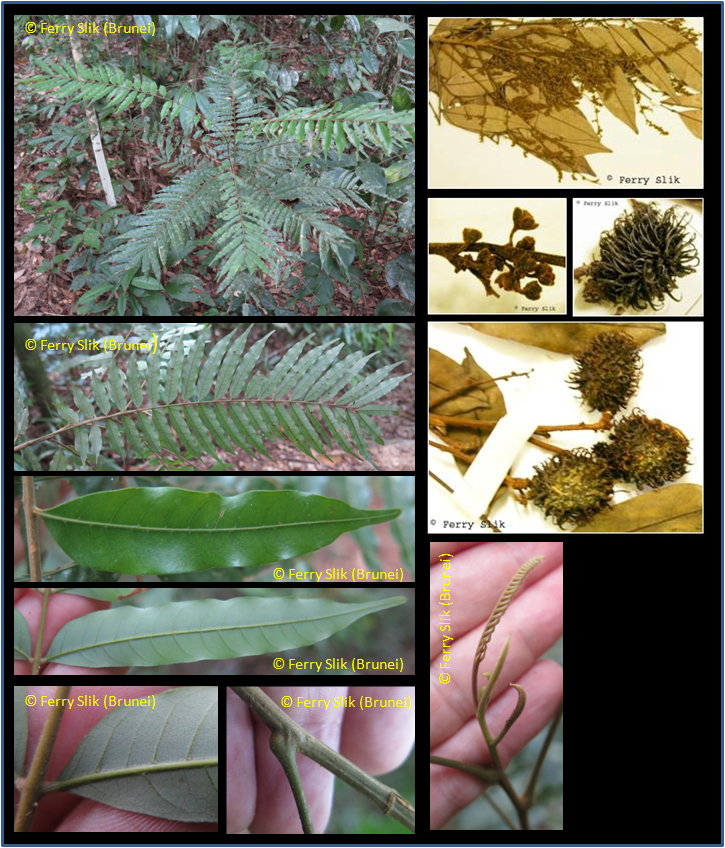Nephelium uncinatum Radlk. ex Leenh., Blumea 31 (1986)
Latin for 'with hooks'.Diagnostics
Mid-canopy tree up to 40 m tall and 63 cm dbh. Stipules absent. Leaves
alternate, compound, leaflets penni-veined, glabrous, whitish below. Flowers ca.
2 mm diameter, yellowish, placed in panicles. Fruits ca. 19 mm long, red, spiny
drupes.
Description
Tree, up to 25(-40?) m high, dbh up to 45(-63) cm,
with up to 1.5 m high buttresses. Twigs 2.5-4.5
mm in diam., puberulous, late glabrescent. Leaves
(1-foliolate to) 3-7(-9, rarely up to 18)-jugate;
petiole 3-9 cm long, 1-1.5 mm thick, terete; axes
densely minutely hairy, rarely fully glabrescent;
petiolules (1-)2-4 mm long, above broadly shallowly
grooved with a strong median rib. Leaflets
(narrowly) elliptic to obovate, sometimes slightly
falcate, 4.8-11 by 1.5-3.5 cm, index 2.5-5(-6),
pergamentaceous, above puberulous in the basal
part of the midrib, to subglabrous, beneath sparsely
hairy on midrib and nerves, in between minutely
sericeous; domatia present; base acute, decurrent;
sides slightly curved; apex tapering to fairly
abruptly acuminate, acumen short (to long), broad,
obtuse (to acute); midrib above raised, nerves 3-8
mm apart, nearly patent, above prominulous, intercalated
veins well developed, veins and veinlets
clearly different, coarsely reticulate, prominulous
but rather inconspicuous on both sides. Inflorescences
terminal or pseudoterminal and in the
upper leaf axils. Sepals c. 25-50 percent connate, in male
flowers 1-1.1 mm, in female ones 1.4-1.5 mm long.
Petals absent. Disc in male flowers fairly strongly
developed, the lobes protruding between the stamens,
in female flowers less conspicuous, glabrous
or with some hairs. Stamens 5 or 6. Ovary 2-celled,
sometimes in the same specimen also 1-celled.
Fruits ellipsoid to subglobular, 2.75-3 by 2-2.25
cm, glabrous, fairly sparsely set with thick warts
tapering into or more abruptly terminated by an up
to 7.5 mm long, filiform, curved appendage; wall
coriaceous, 1-2 mm thick.
Ecology
In undisturbed to slightly disturbed (open sites) mixed dipterocarp and
swamp forests up to 400 m altitude. Mostly on hillsides and ridges on sandy
well drained soils.
Uses
The fruits are edible.
Distribution
Peninsular Malaysia, Sumatra, Borneo.
Local names
Borneo: Kalamangis, Keranji, Kolomangis, Lamun, Lamun-lamun, Lenamun, Rambutan,
Ulomangis.
